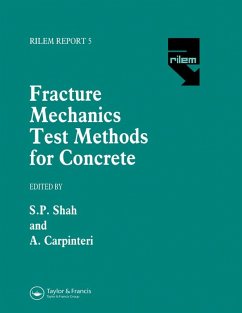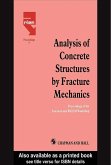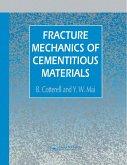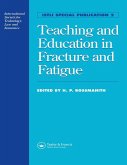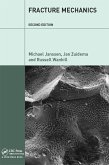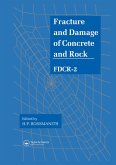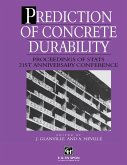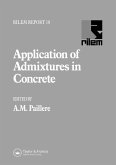Fracture Mechanics Test Methods For Concrete (eBook, PDF)
Redaktion: Shah, Surendra; Carpinteri, Alberto
66,95 €
66,95 €
inkl. MwSt.
Sofort per Download lieferbar

33 °P sammeln
66,95 €
Als Download kaufen

66,95 €
inkl. MwSt.
Sofort per Download lieferbar

33 °P sammeln
Jetzt verschenken
Alle Infos zum eBook verschenken
66,95 €
inkl. MwSt.
Sofort per Download lieferbar
Alle Infos zum eBook verschenken

33 °P sammeln
Fracture Mechanics Test Methods For Concrete (eBook, PDF)
Redaktion: Shah, Surendra; Carpinteri, Alberto
- Format: PDF
- Merkliste
- Auf die Merkliste
- Bewerten Bewerten
- Teilen
- Produkt teilen
- Produkterinnerung
- Produkterinnerung

Bitte loggen Sie sich zunächst in Ihr Kundenkonto ein oder registrieren Sie sich bei
bücher.de, um das eBook-Abo tolino select nutzen zu können.
Hier können Sie sich einloggen
Hier können Sie sich einloggen
Sie sind bereits eingeloggt. Klicken Sie auf 2. tolino select Abo, um fortzufahren.

Bitte loggen Sie sich zunächst in Ihr Kundenkonto ein oder registrieren Sie sich bei bücher.de, um das eBook-Abo tolino select nutzen zu können.
Compares currently used methods in determining concrete toughness and presents recommended test procedures with theories and models for describing cracking and fracturing phenomena. Effects of loading rate, temperature and humidity are also examined. Well referenced and illustrated, this book is filled with practical technical information for mater
- Geräte: PC
- mit Kopierschutz
- eBook Hilfe
Andere Kunden interessierten sich auch für
![Analysis of Concrete Structures by Fracture Mechanics (eBook, PDF) Analysis of Concrete Structures by Fracture Mechanics (eBook, PDF)]() Analysis of Concrete Structures by Fracture Mechanics (eBook, PDF)363,95 €
Analysis of Concrete Structures by Fracture Mechanics (eBook, PDF)363,95 €![Fracture Mechanics of Cementitious Materials (eBook, PDF) Fracture Mechanics of Cementitious Materials (eBook, PDF)]() B. CotterellFracture Mechanics of Cementitious Materials (eBook, PDF)67,95 €
B. CotterellFracture Mechanics of Cementitious Materials (eBook, PDF)67,95 €![Teaching and Education in Fracture and Fatigue (eBook, PDF) Teaching and Education in Fracture and Fatigue (eBook, PDF)]() Teaching and Education in Fracture and Fatigue (eBook, PDF)66,95 €
Teaching and Education in Fracture and Fatigue (eBook, PDF)66,95 €![Fracture Mechanics (eBook, PDF) Fracture Mechanics (eBook, PDF)]() Michael JanssenFracture Mechanics (eBook, PDF)72,95 €
Michael JanssenFracture Mechanics (eBook, PDF)72,95 €![Fracture and Damage of Concrete and Rock - FDCR-2 (eBook, PDF) Fracture and Damage of Concrete and Rock - FDCR-2 (eBook, PDF)]() Fracture and Damage of Concrete and Rock - FDCR-2 (eBook, PDF)64,95 €
Fracture and Damage of Concrete and Rock - FDCR-2 (eBook, PDF)64,95 €![Prediction of Concrete Durability (eBook, PDF) Prediction of Concrete Durability (eBook, PDF)]() Prediction of Concrete Durability (eBook, PDF)64,95 €
Prediction of Concrete Durability (eBook, PDF)64,95 €![Application of Admixtures in Concrete (eBook, PDF) Application of Admixtures in Concrete (eBook, PDF)]() Application of Admixtures in Concrete (eBook, PDF)66,95 €
Application of Admixtures in Concrete (eBook, PDF)66,95 €-
-
-
Compares currently used methods in determining concrete toughness and presents recommended test procedures with theories and models for describing cracking and fracturing phenomena. Effects of loading rate, temperature and humidity are also examined. Well referenced and illustrated, this book is filled with practical technical information for mater
Dieser Download kann aus rechtlichen Gründen nur mit Rechnungsadresse in A, B, BG, CY, CZ, D, DK, EW, E, FIN, F, GR, HR, H, IRL, I, LT, L, LR, M, NL, PL, P, R, S, SLO, SK ausgeliefert werden.
Produktdetails
- Produktdetails
- Verlag: Taylor & Francis eBooks
- Seitenzahl: 300
- Erscheinungstermin: 1. März 2004
- Englisch
- ISBN-13: 9781482267532
- Artikelnr.: 57419068
- Verlag: Taylor & Francis eBooks
- Seitenzahl: 300
- Erscheinungstermin: 1. März 2004
- Englisch
- ISBN-13: 9781482267532
- Artikelnr.: 57419068
- Herstellerkennzeichnung Die Herstellerinformationen sind derzeit nicht verfügbar.
Surendra Shah is Professor of Civil and Environmental Engineering at Northwestern University, McCormack School of Engineering.Alberto Carpinteri is professor in science of construction at the Polytechnic University of Turin.
Preface. RILEM technical committee 89-FMT. Subcommittees. Notched beam
test: mode I fracture toughness. Introduction. Summary and recommendation.
Proposal 1: Two parameter model (TPM). Proposal 2: Size Effect Law (SEL).
Proposal 3: Effective Crack Model (ECM). Comparison of ECM and TPM.
Application of proposed fracture models to large structures.
Acknowledgement. References. Appendices (Test data, Proposal 1 and ECM).
Fracture properties of concrete as determined by means of wedge splitting
tests and tapered double cantilever beam tests. Introduction. Description
of experiments. Experimental results. Determination of Gf-values and
tensile softening diagrams. Evaluation of fracture toughness Kic by the
compliance method. Mode I fracture parameters. Conclusions and
recommendations. References. Mixed-mode crack propagation in concrete.
Introduction. Mixed-mode fracture criteria. Test specimen geometries.
Fracture of concrete in compression. Conclusions. References. Appendix
(Round robin). Loading rate, temperature and humidity effects. Loading rate
effects. Temperature and moisture influence. References. Fracture process
zone detection. Introduction. Compliance measurements. X-ray techniques.
Optical microscopy. Scanning electron microscopy. Electric resistance
strain gauge techniques. Photoelastic methods. Mercury penetration
measurements. Dye penetrants. Infrared vibrothermography. Ultrasonic pulse
velocity. Demec gauges. Acoustic emission. Interferometry techniques.
Multi-cutting techniques. Numerical methods. Conclusions. Acknowledgements.
References. Laser interferometry methods. Holographic interferometry.
Speckle photography. Speckle interferometry. References. Indices.
test: mode I fracture toughness. Introduction. Summary and recommendation.
Proposal 1: Two parameter model (TPM). Proposal 2: Size Effect Law (SEL).
Proposal 3: Effective Crack Model (ECM). Comparison of ECM and TPM.
Application of proposed fracture models to large structures.
Acknowledgement. References. Appendices (Test data, Proposal 1 and ECM).
Fracture properties of concrete as determined by means of wedge splitting
tests and tapered double cantilever beam tests. Introduction. Description
of experiments. Experimental results. Determination of Gf-values and
tensile softening diagrams. Evaluation of fracture toughness Kic by the
compliance method. Mode I fracture parameters. Conclusions and
recommendations. References. Mixed-mode crack propagation in concrete.
Introduction. Mixed-mode fracture criteria. Test specimen geometries.
Fracture of concrete in compression. Conclusions. References. Appendix
(Round robin). Loading rate, temperature and humidity effects. Loading rate
effects. Temperature and moisture influence. References. Fracture process
zone detection. Introduction. Compliance measurements. X-ray techniques.
Optical microscopy. Scanning electron microscopy. Electric resistance
strain gauge techniques. Photoelastic methods. Mercury penetration
measurements. Dye penetrants. Infrared vibrothermography. Ultrasonic pulse
velocity. Demec gauges. Acoustic emission. Interferometry techniques.
Multi-cutting techniques. Numerical methods. Conclusions. Acknowledgements.
References. Laser interferometry methods. Holographic interferometry.
Speckle photography. Speckle interferometry. References. Indices.
Preface. RILEM technical committee 89-FMT. Subcommittees. Notched beam
test: mode I fracture toughness. Introduction. Summary and recommendation.
Proposal 1: Two parameter model (TPM). Proposal 2: Size Effect Law (SEL).
Proposal 3: Effective Crack Model (ECM). Comparison of ECM and TPM.
Application of proposed fracture models to large structures.
Acknowledgement. References. Appendices (Test data, Proposal 1 and ECM).
Fracture properties of concrete as determined by means of wedge splitting
tests and tapered double cantilever beam tests. Introduction. Description
of experiments. Experimental results. Determination of Gf-values and
tensile softening diagrams. Evaluation of fracture toughness Kic by the
compliance method. Mode I fracture parameters. Conclusions and
recommendations. References. Mixed-mode crack propagation in concrete.
Introduction. Mixed-mode fracture criteria. Test specimen geometries.
Fracture of concrete in compression. Conclusions. References. Appendix
(Round robin). Loading rate, temperature and humidity effects. Loading rate
effects. Temperature and moisture influence. References. Fracture process
zone detection. Introduction. Compliance measurements. X-ray techniques.
Optical microscopy. Scanning electron microscopy. Electric resistance
strain gauge techniques. Photoelastic methods. Mercury penetration
measurements. Dye penetrants. Infrared vibrothermography. Ultrasonic pulse
velocity. Demec gauges. Acoustic emission. Interferometry techniques.
Multi-cutting techniques. Numerical methods. Conclusions. Acknowledgements.
References. Laser interferometry methods. Holographic interferometry.
Speckle photography. Speckle interferometry. References. Indices.
test: mode I fracture toughness. Introduction. Summary and recommendation.
Proposal 1: Two parameter model (TPM). Proposal 2: Size Effect Law (SEL).
Proposal 3: Effective Crack Model (ECM). Comparison of ECM and TPM.
Application of proposed fracture models to large structures.
Acknowledgement. References. Appendices (Test data, Proposal 1 and ECM).
Fracture properties of concrete as determined by means of wedge splitting
tests and tapered double cantilever beam tests. Introduction. Description
of experiments. Experimental results. Determination of Gf-values and
tensile softening diagrams. Evaluation of fracture toughness Kic by the
compliance method. Mode I fracture parameters. Conclusions and
recommendations. References. Mixed-mode crack propagation in concrete.
Introduction. Mixed-mode fracture criteria. Test specimen geometries.
Fracture of concrete in compression. Conclusions. References. Appendix
(Round robin). Loading rate, temperature and humidity effects. Loading rate
effects. Temperature and moisture influence. References. Fracture process
zone detection. Introduction. Compliance measurements. X-ray techniques.
Optical microscopy. Scanning electron microscopy. Electric resistance
strain gauge techniques. Photoelastic methods. Mercury penetration
measurements. Dye penetrants. Infrared vibrothermography. Ultrasonic pulse
velocity. Demec gauges. Acoustic emission. Interferometry techniques.
Multi-cutting techniques. Numerical methods. Conclusions. Acknowledgements.
References. Laser interferometry methods. Holographic interferometry.
Speckle photography. Speckle interferometry. References. Indices.
